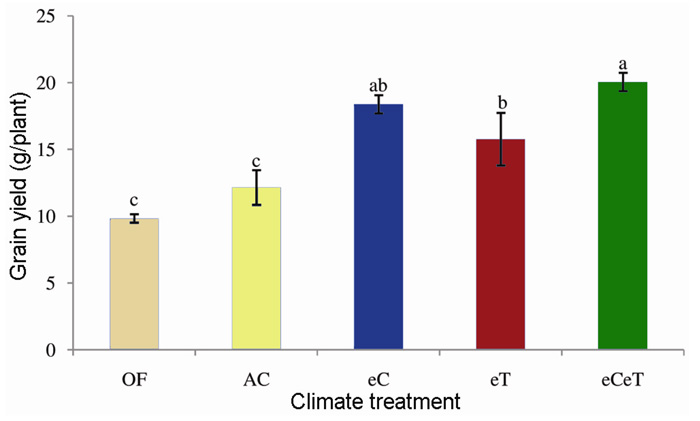| Tweet | Follow @co2science |
Paper Reviewed
Lenka, N.K., Lenka, S., Thakur, J.K., Elanchezhian, R., Sher, S.B., Simaiya, V., Yashona, D.S., Biswas, A.K., Agrawal, P.K. and Patra, A.K. 2017. Interactive effect of elevated carbon dioxide and elevated temperature on growth and yield of soybean. Current Science 113: 2305-2310.
Soybean (Glycine max) is a major crop cultivated in many countries across the globe that is valued for its high protein content. Consequently, it is important to determine how soybeans will likely respond to rising atmospheric CO2 concentrations with and without concomitant increases in air temperature. Such was the recent focus of a study by Lenka et al. (2017).
Working at the research farm of the Indian Institute of Soil Science in Bhopal, India (23.25°N, 77.42°E), the team of ten scientists conducted an open-top chamber study to investigate the growth response of soybean (cv. JS-20-29) to future projected changes in atmospheric CO2 and temperature. Altogether, their experiment consisted of five treatments, including (1) an open field (OF) setting, consisting of ambient temperature and ambient CO2 (~400 ppm) conditions, (2) an ambient chamber (AC), which was also maintained at ambient temperature and ambient CO2, but in a chamber setting so the authors could discern whether or not there were any chamber effects influencing their findings, (3) an elevated CO2 (eC) chamber, (4) an elevated temperature (eT) chamber treatment, and (5) an elevated CO2 and elevated temperature (eCeT) chamber treatment. Elevated CO2 concentrations were maintained at approximately 550 ppm and elevated temperatures were maintained at 2°C above ambient.
Lenka et al. examined the impact of temperature and CO2 on selected soybean growth parameters and yield attributes at various stages of the growing season. Such measurements, in the words of the authors, reveal that there was "a significantly positive effect of CO2 and temperature, individually as well as in combination, on the studied growth characteristics." This positive growth effect was observed in plant height, leaf area, aboveground biomass, pod number, seeds per plant and yield. Compared to ambient conditions, for example, the number of pods per plant was enhanced by approximately 36% in the eC, eT and eCeT treatments. The number of seeds per plant was also greater, increasing by 28%, 12% and 26% in the eC, eT and eCeT treatments, respectively.
Perhaps the most important parameter studied, however, was soybean grain yield. Here, elevated temperature improved this measure by 30%. Elevated CO2, in contrast, stimulated it by a much larger 51%. And when combined in the eCeT treatment, elevated CO2 and elevated temperature boosted the grain yield by an even greater 65%! Consequently, it is clear that if both atmospheric CO2 concentrations and air temperatures rise in the future within the ranges analyzed in this study, soybeans and those who grow them will reap tremendous benefits, including yield enhancements of 50% or more. And that is great news worth celebrating and cheering for!

Figure 1. Soybean grain yield under different CO2 and temperature treatments. Bars with different lower-case letters are significant according to Duncan's multiple range test (P < 0.05). Error bars indicate standard error of the mean. Source: Lenka et al. (2017).




